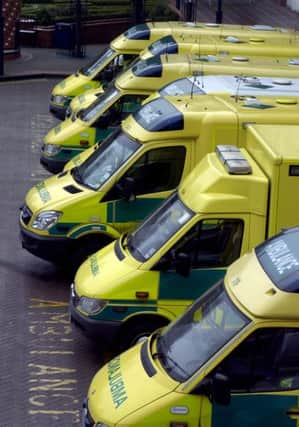Paramedics not on board many Yorkshire ambulances


Across the county, the new data reveals, ambulance crews without a paramedic responded to 62,012 calls which were classed as category 1 or 2.
This amounts to around 14 per cent of calls for those in an emergency or life-threatening situation such as a heart attack, stroke, or burns.
Advertisement
Hide AdAdvertisement
Hide AdYorkshire Ambulance Service (YAS), when asked repeatedly for clarification as to who was staffing these ambulances, failed to respond but instead issued a statement asserting it had “robust” protocols in place.
“We are committed to providing high quality care to all our patients and have robust dispatch protocols in place to ensure we respond appropriately to medical emergencies,” said Dr Steven Dykes, deputy medical director at Yorkshire Ambulance Service NHS Trust.
“In high-priority, time-critical incidents we dispatch the nearest available ambulance resource to the scene, where paramedics or emergency medical technicians (EMTs) can provide immediate life-saving care to patients.”
Despite questions being asked by The Yorkshire Post for clarity around the guidelines and targets for such practice, as well as the difference in care delivery between EMTs and paramedics, YAS refused to comment further.
Advertisement
Hide AdAdvertisement
Hide Ad“Our priority is to get each patient the right resource in the right time,” a spokesman said. “Our priority for a category one call is to send the nearest available resource to ensure the patient receives care as quickly as possible and all our staff are trained in immediate life-saving interventions such as CPR and the recognition of sepsis.
“The needs of our patients are mixed between clinical care and transport to hospital and our workforce reflects that.”
The Freedom of Information request to the YAS asked for a breakdown of the number of 999 calls which were attended to by an emergency care assistant (ECA) rather than a fully qualified paramedic.
This is after concerns were raised by unions in 2013 that the lesser trained ECAs were being sent to emergencies in the county.
Advertisement
Hide AdAdvertisement
Hide AdBut the response from YAS instead showed a breakdown of the total number of calls not attended by a paramedic.
In the year to August 2017, a total of 111,238 ambulances called out in Yorkshire didn’t have a paramedic on board, the figures showed, a rate of 15 per cent.
Furthermore, the data showed, this included 6,525 crews, around eight per cent, which responded to Category 1 calls to those in a life-threatening situation.
Unions have said that all ambulances should have a paramedic on board, but have stressed that any EMTs which are crewing the ambulances are highly trained.
Advertisement
Hide AdAdvertisement
Hide Ad“Unison Yorkshire Ambulance branch would ideally like to see a paramedic on all frontline vehicles,” said spokesman Bryn Webster. “However, the agreed workforce plan has highly trained EMT members as lead clinicians on ambulances. This is whilst they are waiting to undertake paramedic training.
“The EMT grades should only make up approximately 20 per cent of the commissions within the workforce.”
But, he added, there is ongoing “confusion” within the trust about the arrangements of this plan and how it plays out in practice for members.
“There is currently confusion around the agreed workforce plan due to the trust breaking an agreement and disregarding Unison members’ previous ballot results,” he said, referring to issues around rotas, procedures and leave.
Advertisement
Hide AdAdvertisement
Hide Ad“Unison urges the trust to adhere to all policies to avoid further confrontation.”
Yorkshire Ambulance Service NHS Trust receives an average of 2,450 emergency and routine calls per day and employs over 5,000 staff in the region.
NHS England confirmed the make up for ambulance crews is down to individual trusts.
According to the College of Paramedics, EMTs, also known ambulance technicians, work in a clinical role within the ambulance service but are unregistered.
Advertisement
Hide AdAdvertisement
Hide AdThey are trained to a lower standard than paramedics, and are able to administer a smaller range of medicines.
They can however “practice autonomously”, the college says, assessing and treating patients as needed.